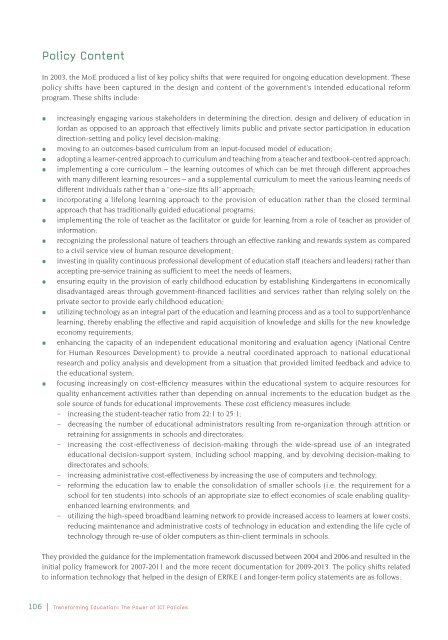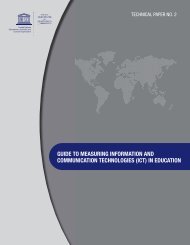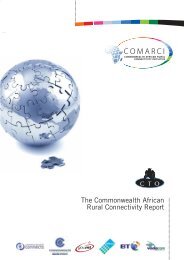Transforming education: the power of ICT policies - Commonwealth ...
Transforming education: the power of ICT policies - Commonwealth ...
Transforming education: the power of ICT policies - Commonwealth ...
You also want an ePaper? Increase the reach of your titles
YUMPU automatically turns print PDFs into web optimized ePapers that Google loves.
Policy Content<br />
In 2003, <strong>the</strong> MoE produced a list <strong>of</strong> key policy shifts that were required for ongoing <strong>education</strong> development. These<br />
policy shifts have been captured in <strong>the</strong> design and content <strong>of</strong> <strong>the</strong> government’s intended <strong>education</strong>al reform<br />
program. These shifts include:<br />
apple increasingly engaging various stakeholders in determining <strong>the</strong> direction, design and delivery <strong>of</strong> <strong>education</strong> in<br />
Jordan as opposed to an approach that effectively limits public and private sector participation in <strong>education</strong><br />
direction-setting and policy level decision-making;<br />
apple moving to an outcomes-based curriculum from an input-focused model <strong>of</strong> <strong>education</strong>;<br />
apple adopting a learner-centred approach to curriculum and teaching from a teacher and textbook-centred approach;<br />
apple implementing a core curriculum – <strong>the</strong> learning outcomes <strong>of</strong> which can be met through different approaches<br />
with many different learning resources – and a supplemental curriculum to meet <strong>the</strong> various learning needs <strong>of</strong><br />
different individuals ra<strong>the</strong>r than a “one-size fi ts all” approach;<br />
apple incorporating a lifelong learning approach to <strong>the</strong> provision <strong>of</strong> <strong>education</strong> ra<strong>the</strong>r than <strong>the</strong> closed terminal<br />
approach that has traditionally guided <strong>education</strong>al programs;<br />
apple implementing <strong>the</strong> role <strong>of</strong> teacher as <strong>the</strong> facilitator or guide for learning from a role <strong>of</strong> teacher as provider <strong>of</strong><br />
information;<br />
apple recognizing <strong>the</strong> pr<strong>of</strong>essional nature <strong>of</strong> teachers through an effective ranking and rewards system as compared<br />
to a civil service view <strong>of</strong> human resource development;<br />
apple investing in quality continuous pr<strong>of</strong>essional development <strong>of</strong> <strong>education</strong> staff (teachers and leaders) ra<strong>the</strong>r than<br />
accepting pre-service training as suffi cient to meet <strong>the</strong> needs <strong>of</strong> learners;<br />
apple ensuring equity in <strong>the</strong> provision <strong>of</strong> early childhood <strong>education</strong> by establishing Kindergartens in economically<br />
disadvantaged areas through government-fi nanced facilities and services ra<strong>the</strong>r than relying solely on <strong>the</strong><br />
private sector to provide early childhood <strong>education</strong>;<br />
apple utilizing technology as an integral part <strong>of</strong> <strong>the</strong> <strong>education</strong> and learning process and as a tool to support/enhance<br />
learning, <strong>the</strong>reby enabling <strong>the</strong> effective and rapid acquisition <strong>of</strong> knowledge and skills for <strong>the</strong> new knowledge<br />
economy requirements;<br />
apple enhancing <strong>the</strong> capacity <strong>of</strong> an independent <strong>education</strong>al monitoring and evaluation agency (National Centre<br />
for Human Resources Development) to provide a neutral coordinated approach to national <strong>education</strong>al<br />
research and policy analysis and development from a situation that provided limited feedback and advice to<br />
<strong>the</strong> <strong>education</strong>al system;<br />
apple focusing increasingly on cost-effi ciency measures within <strong>the</strong> <strong>education</strong>al system to acquire resources for<br />
quality enhancement activities ra<strong>the</strong>r than depending on annual increments to <strong>the</strong> <strong>education</strong> budget as <strong>the</strong><br />
sole source <strong>of</strong> funds for <strong>education</strong>al improvements. These cost effi ciency measures include:<br />
− increasing <strong>the</strong> student-teacher ratio from 22:1 to 25:1;<br />
− decreasing <strong>the</strong> number <strong>of</strong> <strong>education</strong>al administrators resulting from re-organization through attrition or<br />
retraining for assignments in schools and directorates;<br />
− increasing <strong>the</strong> cost-effectiveness <strong>of</strong> decision-making through <strong>the</strong> wide-spread use <strong>of</strong> an integrated<br />
<strong>education</strong>al decision-support system, including school mapping, and by devolving decision-making to<br />
directorates and schools;<br />
− increasing administrative cost-effectiveness by increasing <strong>the</strong> use <strong>of</strong> computers and technology;<br />
− reforming <strong>the</strong> <strong>education</strong> law to enable <strong>the</strong> consolidation <strong>of</strong> smaller schools (i.e. <strong>the</strong> requirement for a<br />
school for ten students) into schools <strong>of</strong> an appropriate size to effect economies <strong>of</strong> scale enabling qualityenhanced<br />
learning environments; and<br />
− utilizing <strong>the</strong> high-speed broadband learning network to provide increased access to learners at lower costs,<br />
reducing maintenance and administrative costs <strong>of</strong> technology in <strong>education</strong> and extending <strong>the</strong> life cycle <strong>of</strong><br />
technology through re-use <strong>of</strong> older computers as thin-client terminals in schools.<br />
They provided <strong>the</strong> guidance for <strong>the</strong> implementation framework discussed between 2004 and 2006 and resulted in <strong>the</strong><br />
initial policy framework for 2007-2011 and <strong>the</strong> more recent documentation for 2009-2013. The policy shifts related<br />
to information technology that helped in <strong>the</strong> design <strong>of</strong> ERfKE I and longer-term policy statements are as follows:<br />
106 | <strong>Transforming</strong> Education: The Power <strong>of</strong> <strong>ICT</strong> Policies
















